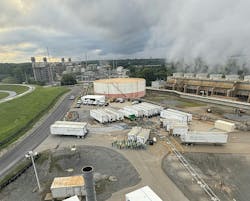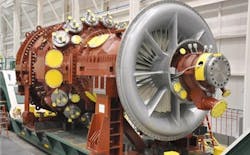50-50 is 100% Progress on H2: Georgia Power, Mitsubishi Achieve Hydrogen Testing Success at Georgia Gas-fired Plant
Georgia Power and Mitsubishi Power have completed a second trial blending hydrogen and natural gas fuels at both partial and full load on an M501GAC natural gas turbine at Georgia Power’s Plant McDonough-Atkinson in Smyrna, Georgia.
The demonstration project has examined 50% hydrogen fuel blending on an advanced class gas turbine, with the 50-50 blend providing about 22% reduction in CO2 emissions as compared to 100% natural gas. Several tests were conducted before the 50% blend demonstration including multiple blend percentages ranging from 5 to 50. The 50-50 Testing was performed in May and June.
In 2024, the existing gas turbine was converted from steam-cooled to air-cooled, which includes J series combustion technology with proven high hydrogen co-firing capability. The conversion provides quick startup times, increased turn down capability and decreased maintenance expenses and also supports the ability for the hydrogen blend testing.
“Natural gas serves a critical role in our generation mix, providing flexibility, baseload power and quick response to customer demand, and will continue to be an important fuel as we plan to meet the energy needs of a growing Georgia through a diverse portfolio of generation resources,” said Rick Anderson, senior vice president and senior production officer for Georgia Power, in a statement. “At Georgia Power, innovative testing such as this is just one way we help ensure we can deliver reliable and affordable energy for customers for decades into the future and reduce our overall emissions.
“Investments we’re making in our fleet and power grid today will benefit future generations, and I’m very proud of the team at Plant McDonough-Atkinson and Mitsubishi Power for their dedication to this project and safely completing this test,” Anderson added.
Southern Co.-owned utility Georgia Power partnered with Mitsubishi Power for the testing for new research and development (R&D) to advance reliable and affordable energy for customers, while reducing carbon emissions across its generation fleet. Georgia Power has reduced its carbon emissions by more than 60% since 2007.
The latest test follows the 20% by volume hydrogen blending test at Plant McDonough-Atkinson completed in 2022.
The Plant McDonough-Atkinson facility, located less than 10 miles from downtown Atlanta, has served electric customers for more than 80 years and was fully converted to natural gas in 2012 and expanded to power up to 1.7 million homes. Currently, it operates with six M501G and M501GAC series gas turbines, which deliver high performance and high efficiency, as well as three steam turbines running in three blocks of 2-on-1 combined-cycle configuration and two gas/oil fueled combustion turbines.
Mitsubishi Power completed the hydrogen blending on one M501GAC gas turbine unit, with an approximate one-on-one output of 283 MW. Mitsubishi Power provided full turnkey service for the project including engineering, planning, hydrogen blending hardware, controls, commissioning and risk management. Mitsubishi Power partnered with Certarus to source and manage the hydrogen supply and logistics.
“It has been a privilege to partner with Georgia Power on this landmark project,” said Mark Bissonnette, executive vice president and chief operating officer of Power Generation at Mitsubishi Power Americas. “Building on the success of our earlier tests, we have achieved a 50% hydrogen blend in an advanced-class gas turbine, showcasing the capabilities of our state-of-the-art technology.”
Hydrogen does not contain carbon in its molecular chain and does not emit carbon dioxide when combusted. It is an energy-dense but lighter gas than methane and requires adaptations in ignition and combustion systems as well as pipelines.
Hydrogen is the most abundant element on earth but it is not easily generated for commercial purposes. To produce hydrogen at scale, it just be taken from natural gas through steam reforming, which is carbon intensive, or by electricity-powered electrolyzers which split the H2 from water.
To be classified as green hydrogen, the electrolyzers should be powered from carbon-free resources such as wind, solar, hydro or nuclear.

